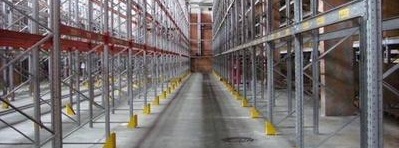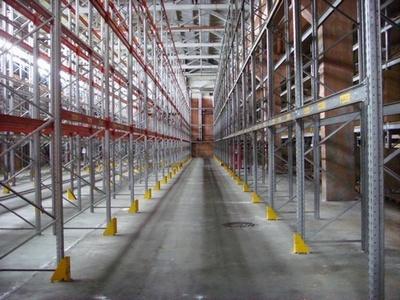Setting up an Efficient Warehouse
| |||||
|
["{div class=objectGalleryCell style=\"background:url(\/images\/stellazhi.jpg) center center \/ cover no-repeat;\"}{img src=\"\/images\/stellazhi.jpg\" style=\"opacity:0;width:100%;height:100%;\"}{\/div}"] |
|
||||
|
Since larger amounts of inventory are required for a longer supply chain (inventory ensures the availability of the product), this excessive inventory needs to be unloaded, stored and secured in the warehouses until it becomes necessary. Never minding if you are manufacturing locally or offshore, you have to pay a special attention to optimizing storage space in your warehouse. Its layout and rack choices are primary factors defining efficient product flow and, thus, your warehouse competitiveness. Setting up a warehouse in a right place will significantly reduce your costs due to stored inventory reduction, forklifts minimization, fuel and repair cost reduction, extraneous physical counts elimination, and efficient product organization. How to Plan Warehouse Layout: The first step – is to consider your overall strategy of storage. Before you set any warehouse rack, think about the material flow first. Consider the path of incoming material before designing shipping docks. How often will it arrive? How long will it need to be stored? Where will you set the forklift tracks? To optimize forklift travel, you will have to send forklifts travelling small distances to frequent goods locations and forklifts travelling long distances to less frequent storage locations. Thus, your drivers will be able to move quicker, at the same time reducing chances of any accidents. Your warehouse space should be optimized in order to avoid dead space. Such places and awkward corners are the Bermuda triangle for your goods. They invite workers to set the goods down for a minute, only to remain there forever. Make sure that each area is designed for a particular product and all goods are labeled accordingly. Considering the entire material path (from incoming to outgoing goods) will help you see any restrictions in flow. For spacious warehouses, it is wise to separate loading and unloading docks. In this manner, you will have goods flowing from one dock to another. Storage space will thus be located between these two docks. Choosing the Right Racks Once you have determined the warehouse flow, you have to think over the racks, making best use of the floor space. The goods shipped by truck are stored on pallets, therefore, you will have to choose between different options of pallet racks. Standard pallet racks are perfect for a typical facility with high turnover and wide range of goods. With this system, every pallet on a pallet rack will be accessible to driver, ensuring that no parts will be lost for years. You can also label each storage location, clearly indicating it either on a piece of paper or on an electronic list. Thus, it will be easy to follow a grid schematic, allowing material handler to track rows and columns until he get to a desired location. However, such benefits come at a cost. With this scheme you will need an aisle between the racks, allowing a forklift to reach the pallet. In some cases, though, it won't be necessary. Since at times the entire truck delivers the same product, these products can be stored in rows. Two rows of pallet can be stored with the help of double deep pallet racks. However, your back rows will not be accessible until the front ones are removed. Such distribution of racks increases the floor space and eliminates extra aisles. However, your forklifts will have to be equipped with a special extended fork, able to reach to the second pallet row. Push back racks can become an alternative to double deep racks. Push back racks do not require any special forklifts. A forklift can load the first row onto a rolling cart. The next pallet will be loaded in the same location, pushing the first pallet to the back row, allowing it to roll freely on the cart. After removing of the first pallet, the back one rolls forward into the front position. Maximum density can be achieved by drive-in and drive-through racks. Such racks allow forklifts to drive into the rows, meaning that two or three (sometimes even more) rows can be stored one after another. The forklifts can access the material from the back when the front is empty. This system is suitable for storage of the same product, since the order does not matter any longer. If "First In First Out" principle (FIFO) is important, a pallet flow rack will be the best option for you. Sometimes, especially with perishable items, it is essential to use the material that came first. This is first of all applicable to food products, since most of them have short shelf lives. Pallet flow racks loading products from one end and unloading them from another one. Such pallets rest on inclined rollers while gravity forces them to the lower end. While loading from the back, the pallets flow to the front to be unloaded. Thus, the first pallet that has been loaded will be the first one to be unloaded, explaining the term 'FIFO'. There is a wide range of warehouse racks. A specific type will depend on material flow, shelf life of the product and the variety of stored pallets as well. In any case, you will have to choose between density and accessibility. The denser you pack the product, the more difficult it is to reach. Therefore, the proper choice of the warehouse racks and an optimized layout is your only solution in this competitive sphere of business. |









 Manufacturing has become a competitive environment due to slim profit margins and a large amount of companies' outsourcing fabrication to territories with cheaper labor costs. The paradox, however, is that cheap labor comes at expensive price.
Manufacturing has become a competitive environment due to slim profit margins and a large amount of companies' outsourcing fabrication to territories with cheaper labor costs. The paradox, however, is that cheap labor comes at expensive price.




